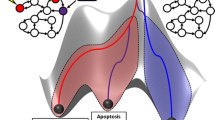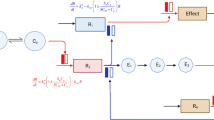Abstract
Quantitative Systems Pharmacology (QSP) models capture the physiological underpinnings driving the response to a drug and express those in a semi-mechanistic way, often involving ordinary differential equations (ODEs). The process of developing a QSP model generally starts with the definition of a set of reasonable hypotheses that would support a mechanistic interpretation of the expected response which are used to form a network of interacting elements. This is a hypothesis-driven and knowledge-driven approach, relying on prior information about the structure of the network. However, with recent advances in our ability to generate large datasets rapidly, often in a hypothesis-neutral manner, the opportunity emerges to explore data-driven approaches to establish the network topologies and models in a robust, repeatable manner. In this paper, we explore the possibility of developing complex network representations of physiological responses to pharmaceuticals using a logic-based analysis of available data and then convert the logic relations to dynamic ODE-based models. We discuss an integrated pipeline for converting data to QSP models. This pipeline includes using k-means clustering to binarize continuous data, inferring likely network relationships using a Best-Fit Extension method to create a Boolean network, and finally converting the Boolean network to a continuous ODE model. We utilized an existing QSP model for the dual-affinity re-targeting antibody flotetuzumab to demonstrate the robustness of the process. Key output variables from the QSP model were used to generate a continuous data set for use in the pipeline. This dataset was used to reconstruct a possible model. This reconstruction had no false-positive relationships, and the output of each of the species was similar to that of the original QSP model. This demonstrates the ability to accurately infer relationships in a hypothesis-neutral manner without prior knowledge of a system using this pipeline.











Similar content being viewed by others
References
Emmert-Streib F, Dehmer M (2011) Networks for systems biology: conceptual connection of data and function. IET Syst Biol 5(3):185–207
Berger SI, Iyengar R (2009) Network analyses in systems pharmacology. Bioinformatics 25(19):2466–2472
Berger SI, Iyengar R (2011) Role of systems pharmacology in understanding drug adverse events. Wiley Interdiscip Rev Syst Biol Med 3(2):129–135
Danhof M (2016) Systems pharmacology–towards the modeling of network interactions. Eur J Pharm Sci 94:4–14
Wist AD, Berger SI, Iyengar R (2009) Systems pharmacology and genome medicine: a future perspective. Genome Med 1(1):11
Del Sol A et al (2010) Diseases as network perturbations. Curr Opin Biotechnol 21(4):566–571
Jordan F, Nguyen TP, Liu WC (2012) Studying protein-protein interaction networks: a systems view on diseases. Brief Funct Genomics 11(6):497–504
Biane C, Delaplace F (2017) Abduction based drug target discovery using Boolean control network. International Conference on Computational Methods in Systems Biology. Springer.
Haanstra JR, Bakker BM (2015) Drug target identification through systems biology. Drug Discov Today Technol 15:17–22
Huang J. et al (2013) Systematic prediction of pharmacodynamic drug-drug interactions through protein-protein-interaction network. 9(3):e1002998.
Ayyar VS, Jusko W (2020) Transitioning from basic towards systems pharmacodynamic models: lessons from corticosteroids. Pharmacol Rev 72:1–25
Friedrich CM (2016) A model qualification method for mechanistic physiological QSP models to support model-informed drug development. CPT: Pharmacometr Syst Pharmaco 5(2):43–53
Androulakis IP (2016) Quantitative systems pharmacology: a framework for context. Curr Pharmacol Rep 2(3):152–160
Androulakis IP (2015) Systems engineering meets quantitative systems pharmacology: from low-level targets to engaging the host defenses. Wiley Interdisc Rev 7(3):101–112
Peterson MC, Riggs MM (2015) FDA advisory meeting clinical pharmacology review utilizes a quantitative systems pharmacology (QSP) model: a watershed moment. CPT Pharmacometrics Syst Pharmacol 4(3):e00020
Putnins M, Androulakis IP (2019) Boolean modeling in quantitative systems pharmacology: challenges and opportunities. Crit Rev Biomed Eng 47(6):473–488
Kauffman S (1969) Homeostasis and differentiation in random genetic control networks. Nature 224(5215):177–178
Thomas R (1973) Boolean formalization of genetic control circuits. J Theor Biol 42(3):563–585
Glass L, Kauffman SA (1973) The logical analysis of continuous, non-linear biochemical control networks. J Theor Biol 39(1):103–129
Kraeutler MJ, Soltis AR, Saucerman JJ (2010) Modeling cardiac β-adrenergic signaling with normalized-Hill differential equations: comparison with a biochemical model. BMC Syst Biol 4(1):1–12
Morris MK et al (2010) Logic-based models for the analysis of cell signaling networks. Biochemistry 49(15):3216–3224
Balbas-Martinez V et al. (2018) A systems pharmacology model for inflammatory bowel disease. 13(3):e0192949.
Bloomingdale P, Niu J, Mager DE (2018) Boolean network modeling in systems pharmacology. J Pharmacokinet Pharmacodyn 45(1):159–180
Thakar J et al (2007) Modeling systems-level regulation of host immune responses. PLoS Comput Biol 3(6):e109
Birtwistle M, Mager D, Gallo J (2013) Mechanistic vs Empirical network models of drug action. CPT Pharmacometr Syst Pharmacol 2(9):1–3
Müssel C, Hopfensitz M, Kestler HA (2010) BoolNet—an R package for generation, reconstruction and analysis of Boolean networks. Bioinformatics 26(10):1378–1380
Terfve C et al (2012) CellNOptR: a flexible toolkit to train protein signaling networks to data using multiple logic formalisms. BMC Syst Biol 6(1):1–14
Krumsiek J et al (2010) Odefy-from discrete to continuous models. 11(1):1-10
Wittmann DM et al (2009) Transforming Boolean models to continuous models: methodology and application to T-cell receptor signaling. BMC Syst Biol 3(1):98
Carter GW (2005) Inferring network interactions within a cell. Brief Bioinform 6(4):380–389
Wang RS et al (2007) Inferring transcriptional regulatory networks from high-throughput data. Bioinformatics 23(22):3056–3064
Gao S et al (2018) Efficient Boolean modeling of gene regulatory networks via random forest based feature selection and best-fit extension. In: 2018 IEEE 14th International Conference on Control and Automation (ICCA). IEEE
Campagne O et al (2018) Integrated pharmacokinetic/pharmacodynamic model of a bispecific CD3xCD123 DART molecule in nonhuman primates: evaluation of activity and impact of immunogenicity. Clin Cancer Res 24(11):2631–2641
Chichili GR et al (2015) A CD3xCD123 bispecific DART for redirecting host T cells to myelogenous leukemia: preclinical activity and safety in nonhuman primates. Sci Transl Med 7(289):289ra82
Boros E, Ibaraki T, Makino K (1998) Error-free and best-fit extensions of partially defined Boolean functions. Inf Comput 140(2):254–283
Saez-Rodriguez J et al (2009) Discrete logic modelling as a means to link protein signalling networks with functional analysis of mammalian signal transduction. Mol Syst Biol 5(1):331
Barman S, Kwon Y-KJPO (2017) A novel mutual information-based Boolean network inference method from time-series gene expression data. PloS One 12(2):e0171097
Lukacs PM, Burnham KP, Anderson DR (2010) Model selection bias and Freedman’s paradox. Ann Inst Stat Math 62(1):117
Nordling TE (2013) Robust inference of gene regulatory networks. PhD, KTH Royal Institute of Technology
Cheng D, Qi H, Li Z (2011) Model construction of Boolean network via observed data. IEEE Trans Neural Netw 22(4):525–536
Gonçalves J, Warnick S (2008) Necessary and sufficient conditions for dynamical structure reconstruction of LTI networks. IEEE Trans Autom Control 53(7):1670–1674
Berestovsky N, Nakhleh L (2013) An evaluation of methods for inferring Boolean networks from time-series data. PLoS One 8(6):e66031
Hopfensitz M et al (2012) Multiscale binarization of gene expression data for reconstructing Boolean networks. IEEE/ACM Trans Comput Biol Bioinform 9(2):487–498
Zhou X, Wang X, Dougherty ER (2003) Binarization of microarray data on the basis of a mixture model. J Mol Cancer Ther 2(7):679–684
Shmulevich I, Kauffman SA, Aldana M (2005) Eukaryotic cells are dynamically ordered or critical but not chaotic. Proc Natl Acad Sci 102(38):13439–13444
Trinh H-C, Kwon Y-K (2021) A novel constrained genetic algorithm-based Boolean network inference method from steady-state gene expression data. Bioinformatics 37(Supplement_1):i383–i391
Charlebois DA et al (2007) Effects of microarray noise on inference efficiency of a stochastic model of gene networks. WSEAS Trans Biol Biomed 4:15–21
Guan KL et al (2000) Negative regulation of the serine/threonine kinase B-Raf by Akt. J Biol Chem 275(35):27354–27359
Trakul N et al (2005) Raf kinase inhibitory protein regulates Raf-1 but not B-Raf kinase activation. J Biol Chem 280(26):24931–24940
Tabus I, Astola J (2001) On the use of MDL principle in gene expression prediction. EURASIP J Appl Signal Process 4:297–303
Kim H, Lee JK, Park TJBB (2007) Boolean networks using the chi-square test for inferring large-scale gene regulatory networks. BMC Bioinformatics 8(1):1–15
Valiant LG (2009) Evolvability. J ACM 56(1):1–21
Abramovici M, Breuer MA, Friedman AD (1990) Digital systems testing and testable design. Vol. 2. Computer science press New York
Sridharan S et al (2012) Boolean modeling and fault diagnosis in oxidative stress response. BMC Genomics 13(6):S4
Layek R et al (2011) Cancer therapy design based on pathway logic. Bioinformatics 27(4):548–555
Lin PC, Khatri SP (2012) Application of Max-SAT-based ATPG to optimal cancer therapy design. BMC Genomics 13(6):S5
Mohanty AK, Datta A, Venkatraj J (2012) Determining the relative prevalence of different subpopulations in heterogeneous cancer tissue. In: Proceedings 2012 IEEE International workshop on genomic signal processing and statistics (GENSIPS). IEEE.
Ghanbarnejad F, Klemm K (2011) Stability of Boolean and continuous dynamics. Phys Rev Lett 107(18):188701
Ruiz-Cerdá ML et al (2016) Towards patient stratification and treatment in the autoimmune disease lupus erythematosus using a systems pharmacology approach. Eur J Pharm Sci 94:46–58
Saadatpour A, Albert R, Reluga TC (2013) A reduction method for Boolean network models proven to conserve attractors. SIAM J Appl Dyn Syst 12(4):1997–2011
Veliz-Cuba A (2011) Reduction of Boolean network models. J Theor Biol 289:167–172
Zanudo JG, Albert R (2013) An effective network reduction approach to find the dynamical repertoire of discrete dynamic networks. Chaos 23(2):025111
Weiss JN (1997) The Hill equation revisited: uses and misuses. FASEB J 11(11):835–841
Acknowledgements
IPA acknowledges support from NIH GM131800.
Author information
Authors and Affiliations
Corresponding author
Additional information
Publisher's Note
Springer Nature remains neutral with regard to jurisdictional claims in published maps and institutional affiliations.
Rights and permissions
About this article
Cite this article
Putnins, M., Campagne, O., Mager, D.E. et al. From data to QSP models: a pipeline for using Boolean networks for hypothesis inference and dynamic model building. J Pharmacokinet Pharmacodyn 49, 101–115 (2022). https://doi.org/10.1007/s10928-021-09797-2
Received:
Accepted:
Published:
Issue Date:
DOI: https://doi.org/10.1007/s10928-021-09797-2




